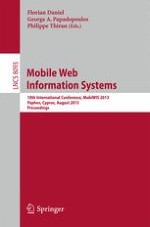This book constitutes the refereed proceedings of the 10 th International Conference on Mobile Web Information Systems, MobiWIS 2013, held in Paphos, Cyprus, in August 2013. The 25 papers (20 full research papers, 4 demonstration papers, and one abstract of the keynote speech) presented were carefully reviewed and selected from various submissions. The papers cover the following topics related to mobile Web and Information Systems (WISs), such as mobile Web services, location-awareness, design and development, social computing and society, development infrastructures and services, SOA and trust, UI migration and human factors, and Web of Things and networks.
